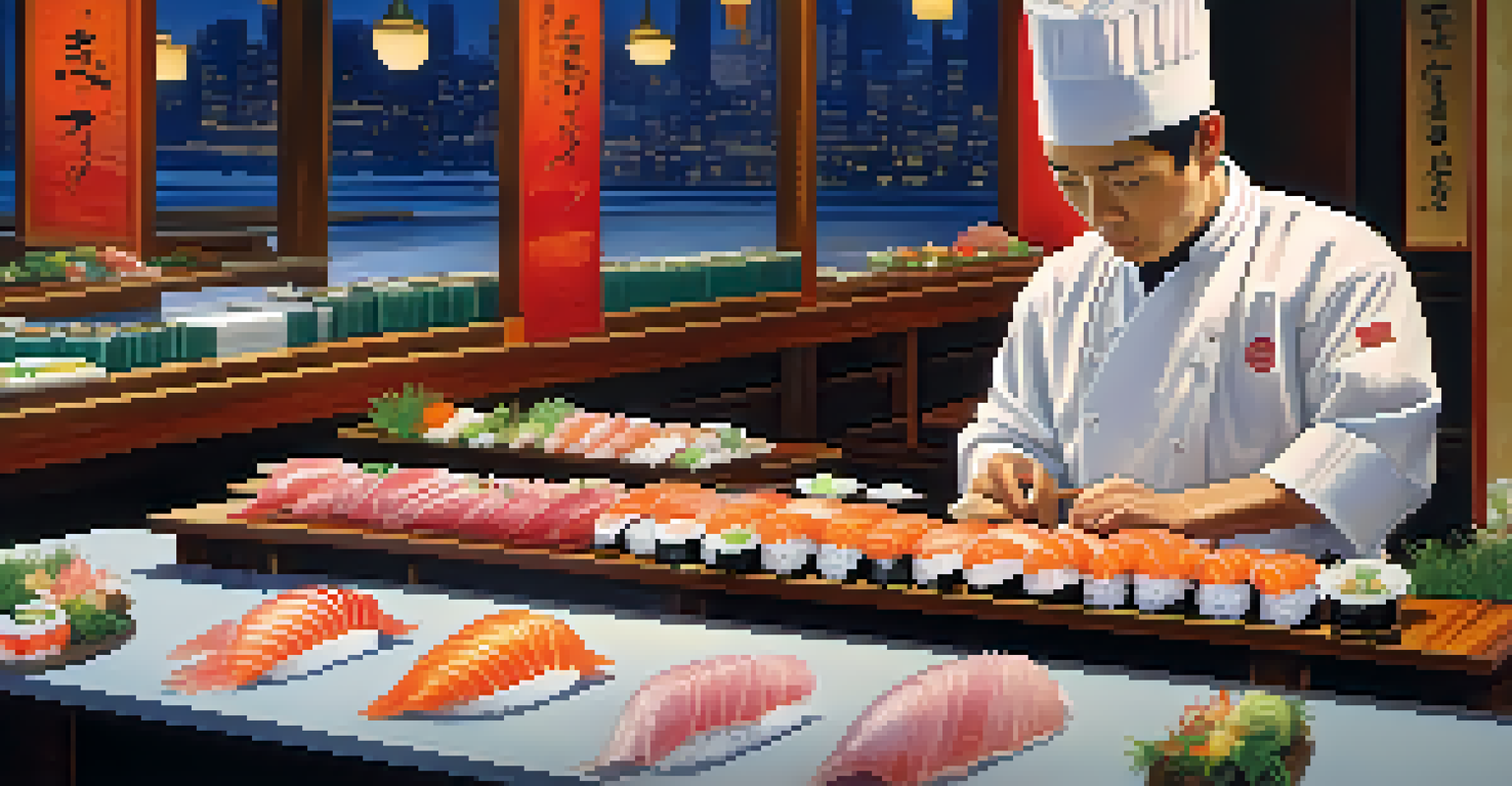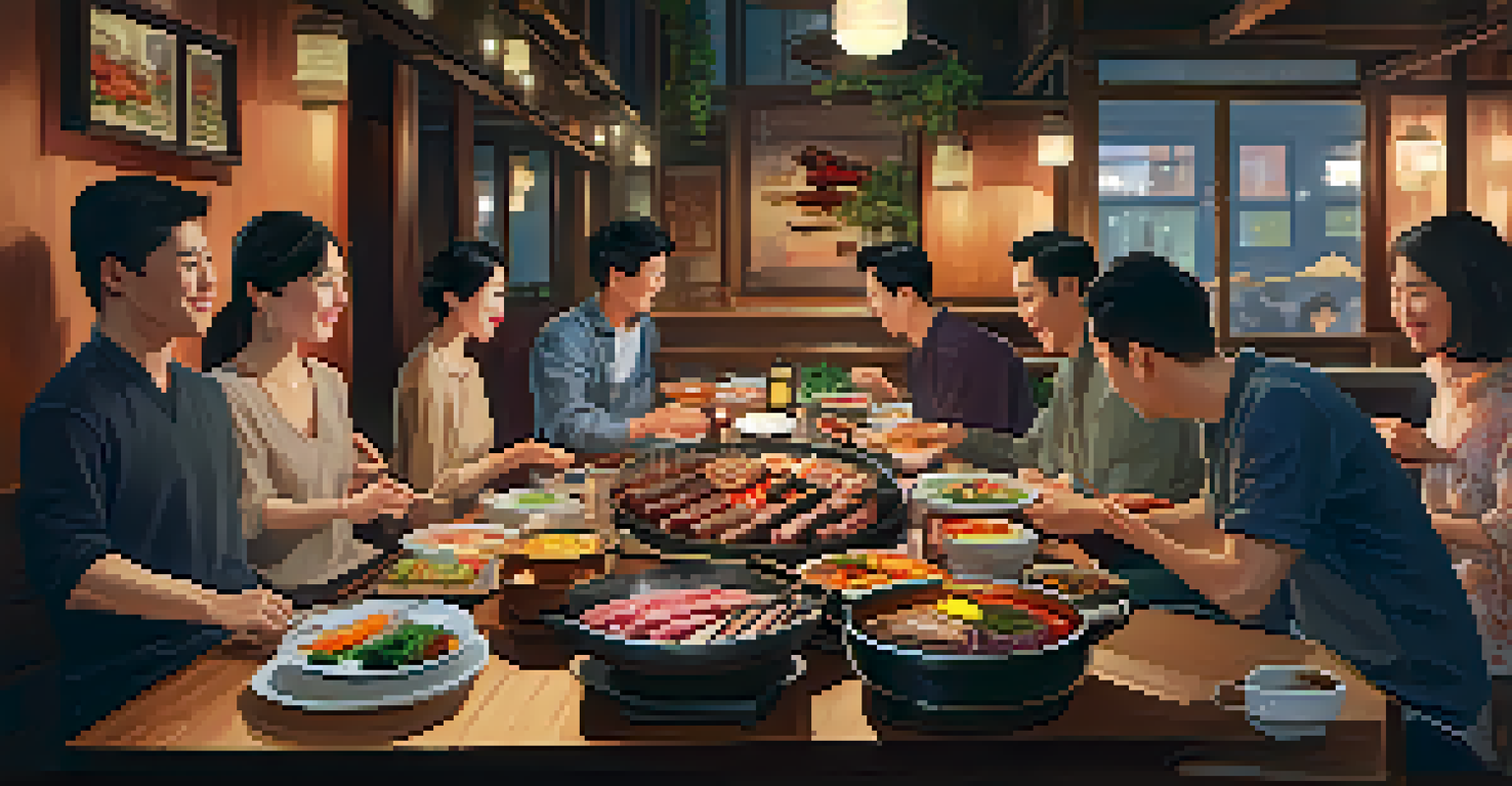Exploring the Impact of Asian Communities on NYC's Culinary Scene

A Brief History of Asian Immigration to NYC
Asian immigration to New York City dates back to the 19th century, starting with Chinese laborers who arrived during the Gold Rush. This influx laid the groundwork for vibrant neighborhoods like Chinatown, which became a cultural hub. Over the decades, waves of immigrants from various Asian countries have enriched the city’s cultural tapestry, bringing with them unique culinary traditions.
Food is our common ground, a universal experience.
The late 20th century saw a significant increase in the number of immigrants from Southeast Asia, including Vietnam, Thailand, and the Philippines. Each group added its own flavors and cooking techniques, transforming NYC into a melting pot of Asian cuisines. This diverse heritage has not only introduced new dishes but also sparked a culinary revolution, influencing dining trends across the city.
Today, NYC boasts a rich array of Asian restaurants, from street food vendors to high-end establishments. This culinary evolution reflects the stories and struggles of the communities who have called the city home. Understanding this history is essential to appreciating the impact of these communities on NYC's food scene.
The Rise of Chinatown as a Culinary Destination
Chinatown has long been recognized as one of the premier destinations for authentic Chinese cuisine in NYC. The neighborhood’s bustling streets are lined with restaurants offering everything from dim sum to Peking duck, drawing locals and tourists alike. This vibrant area not only serves traditional dishes but also showcases regional specialties from various parts of China.

In recent years, Chinatown has expanded its culinary offerings to include fusion and modern interpretations of classic dishes. New establishments blend traditional recipes with contemporary techniques, appealing to a broader audience. This evolution demonstrates how the culinary scene can adapt while still honoring its roots, creating a dynamic dining experience.
Asian Immigration Shapes NYC's Cuisine
The rich history of Asian immigration has led to a diverse culinary landscape in NYC, with neighborhoods like Chinatown becoming cultural and culinary hubs.
Chinatown also plays a crucial role in preserving cultural heritage through food. Festivals and events celebrate traditional cooking methods and ingredients, ensuring that younger generations remain connected to their culinary heritage. As a result, Chinatown continues to be a vital part of NYC's diverse food landscape.
Tokyo Meets NYC: The Sushi Phenomenon
Sushi has become synonymous with Japanese cuisine, and its popularity in NYC has exploded over the past few decades. What started as a niche offering has transformed into a staple on menus across the city, from casual takeout to elegant sushi bars. The artistry and precision involved in sushi-making have captivated food lovers, contributing to its widespread appeal.
In cooking, as in all the arts, simplicity is the sign of perfection.
Many sushi chefs in NYC are trained in traditional Japanese techniques, bringing authenticity to their craft. This dedication to quality has elevated sushi dining experiences, making them not just meals but culinary events. As the sushi craze continues to grow, new trends such as sushi burritos and poke bowls have emerged, showcasing the innovative spirit of NYC's culinary scene.
Moreover, sushi has encouraged a greater appreciation for Japanese culture and gastronomy. As diners explore sushi, they also discover other elements of Japanese cuisine, such as ramen and izakaya-style dining. This interconnectedness highlights how a single dish can open the door to a broader understanding of a culture.
Korean BBQ: An Interactive Dining Experience
Korean BBQ has taken NYC by storm, offering an interactive and communal dining experience that many locals have come to love. Diners can grill their own meats right at the table, creating a fun and engaging atmosphere. This hands-on approach not only makes meals more enjoyable but also fosters a sense of community among diners.
The variety of marinated meats and side dishes, known as banchan, adds to the appeal of Korean BBQ. Each meal is a feast for the senses, with vibrant flavors and a colorful presentation. As more people discover the joys of Korean BBQ, restaurants have begun to pop up throughout the city, catering to diverse tastes and preferences.
Chinatown's Evolving Food Scene
Chinatown not only offers authentic Chinese dishes but also embraces modern interpretations and fusion cuisine, preserving cultural heritage while appealing to a wider audience.
Korean BBQ also reflects broader trends in the culinary world, including the rise of social dining experiences. As people increasingly seek out meals that encourage interaction and connection, Korean BBQ restaurants are well-positioned to thrive. This trend not only highlights the influence of Asian communities on NYC's culinary scene but also showcases the evolving nature of dining.
Thai Cuisine: A Blend of Flavors and Cultures
Thai cuisine is celebrated for its balance of flavors—sweet, sour, salty, and spicy—and has firmly established itself in NYC. Dishes like pad Thai and green curry have become household names, with many restaurants offering authentic recipes alongside creative twists. This versatility allows Thai food to appeal to a broad audience, whether they are adventurous eaters or those seeking comfort food.
The growth of Thai restaurants in NYC reflects the increasing popularity of Southeast Asian cuisine. With each new establishment, chefs introduce diners to lesser-known dishes, expanding their palates and culinary horizons. This exploration fosters an appreciation for the complexity of Thai flavors and the artistry behind its cooking techniques.
Moreover, the rise of food delivery services has made Thai cuisine more accessible than ever. Whether ordering a spicy tom yum soup or a refreshing papaya salad, New Yorkers can enjoy a taste of Thailand from the comfort of their homes. This accessibility has played a significant role in solidifying Thai cuisine’s place in the city's diverse culinary landscape.
Indian Cuisine: Spice and Diversity in NYC
Indian cuisine offers a rich tapestry of flavors, spices, and regional specialties that have captivated NYC diners. From the vibrant curries of North India to the aromatic dishes of South India, the variety is astounding. This diversity is reflected in the number of Indian restaurants that have sprouted up across the city, each offering unique culinary traditions.
The popularity of Indian food has also led to the emergence of fusion dishes that blend traditional Indian flavors with other cuisines. For example, Indian-style tacos and dosas filled with global ingredients have become trendy offerings, appealing to adventurous eaters. This creative approach showcases the adaptability of Indian cuisine within NYC's ever-evolving food scene.
Future of Asian Cuisine is Innovative
The future of NYC's Asian culinary scene promises exciting innovations as chefs blend traditional recipes with global influences, reflecting the vibrant diversity of the city.
Additionally, Indian food's emphasis on vegetarian and vegan options resonates with many health-conscious diners. As more people seek plant-based alternatives, Indian cuisine provides an abundance of delicious choices without compromising flavor. This trend further cements the role of Indian communities in shaping NYC’s diverse culinary landscape.
The Future of NYC's Asian Culinary Scene
As Asian communities continue to thrive in NYC, their culinary influence is likely to grow even stronger. Chefs are increasingly experimenting with traditional recipes, incorporating global flavors and techniques that reflect the city's diversity. This innovation ensures that the culinary landscape remains dynamic and exciting for food lovers.
Moreover, the rise of food festivals and pop-up events highlights the creativity of Asian chefs and restaurateurs. These platforms allow them to showcase their culinary skills and introduce new concepts to a wider audience. As these events gain popularity, they help to elevate Asian cuisine within NYC's culinary hierarchy.

The future of NYC's Asian culinary scene is bright, with a promising blend of tradition and innovation. As communities continue to share their stories through food, diners can expect to experience a tapestry of flavors that reflects the rich cultural heritage of the city. This ongoing evolution will undoubtedly keep the culinary scene vibrant for years to come.